1993 CHEVROLET CORVETTE tires
[x] Cancel search: tiresPage 114 of 370

Downloaded from www.Manualslib.com manuals search engine P
Low 7ire Pressure Warning Light
(OPTION)
The LTPWS has a sensor 'on each road
wheel that transmits-to
a receiver on the
instrument panel.
The system operates
on a radio frequency subject
to Federal
Communications Cbmission
(FCC)
Ruks.
This device complies with Part 15 of the
FCC Rules. Operation is subject to the
following
two conditions: (1) This
device may not cause harmful
interhence,
and (2) This device.must
accept
any interhence received,
including interference that-may cause
undesired operation.
Changes or modifications to- this system
by other than an authorized service
facility could void authorization to use
this equipment.
The Low Tre Pressure Warning System
(LTPWS) monitors the
air pressure in
each road tire (except the spare tire)
while the car is being driven. The
LTFWS will not warn the driver if a tire
is
already flat before the vehicle is started.
This light comes on whenever a tire
pressure
goes below 25 psi (I 75 Ha) in
any road tire while your Corvette is being
driven.
You must drive the car faster than
25 mph (40 km/h) and for more than 2
miles (4 h) -for the system to work
properly.
The Low Tire Pressure Warming
Light also warns you if any of the
system's comp.onents-are not working
properly. The
LOW TIRE PRESSURE
light will remain on until the ignition is
turned
off. This will also reset the system.
When the LOW TIRE PRESSURE
fight comes on, check the tire -pressure
.in
all four road tires as soon as you can,
using the
tire pre:ssure gage.provided in
thesenter console. Adjust the tire
pressure as needed to those shown on
the Tire-Loading Information label
10-cated
on the driver's door, The LOW
TIRE PRESSURE light may come on
if your vehicle is close to aaother
vehicle that has
a Low Tire Pressure
Warning System
and has a tire-with low
pressure.
The LTPWS sensor is directly opposite
the valve stem on the tire. Take extreme
care when servicing or
having your tires
serviced. The sensors may not work
properly
if damaged.
If you need to take the tire off the wheel,
do it at a
90" angle from the valve stem.
Removing the tire from the wheel at any
.. 1
Page 115 of 370
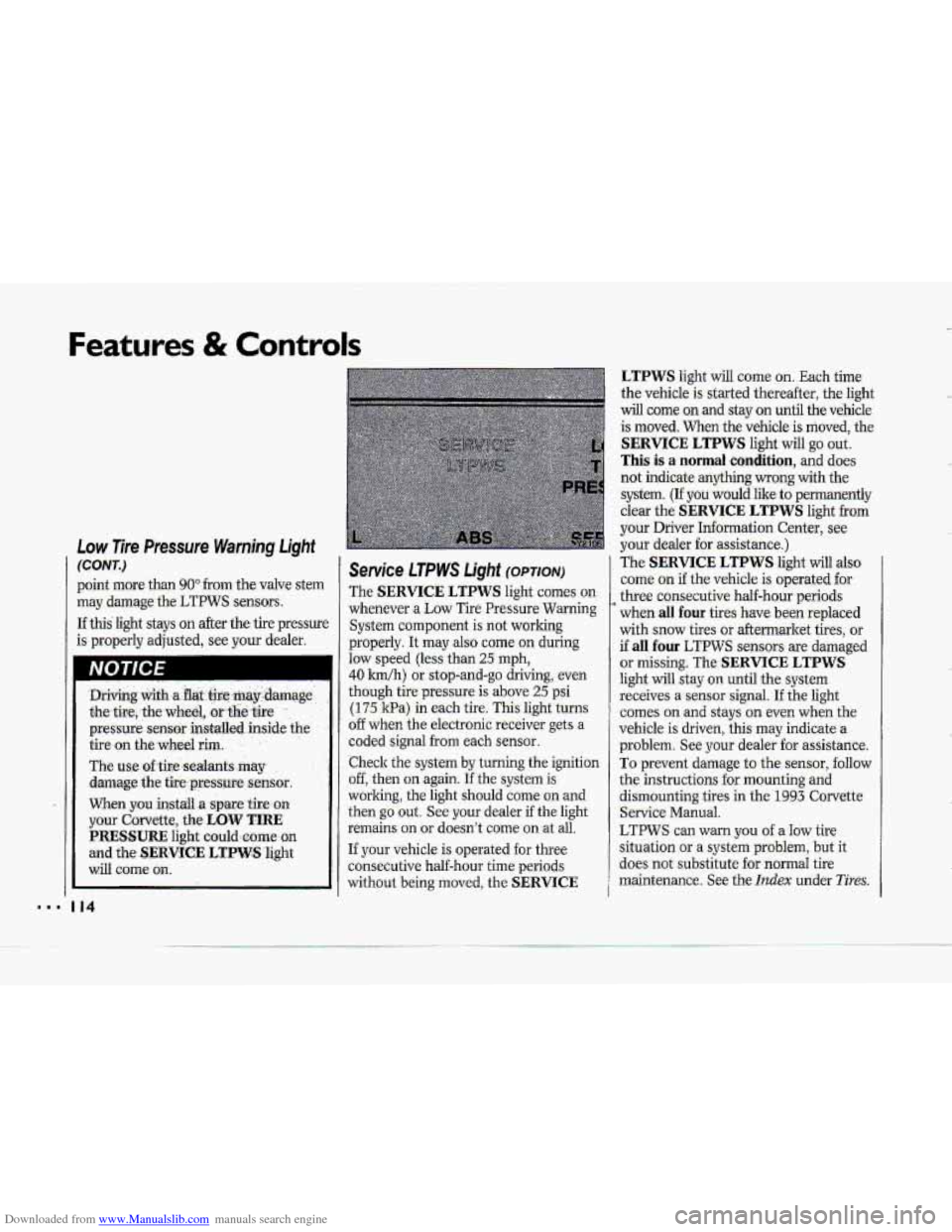
Downloaded from www.Manualslib.com manuals search engine Features & Contro1.s
point more than 90" from the valve stem
may damage the LTPWS sensors..
If this light stays on after the tire pressure
is properly adjusted, see your dealer.
I14
Service LTPWS Light (OPTION)
The SERVICE LTPWS light comes on
whenever a Low Tire PressureWrtming
System component is not working
properly. It
may also come on during
law speed (less than 25 rnph,
40 Idh) or. stop-and-go driving, even
though tire pressure is above 25 psi
(175 kPa-) in each tire. This light turns
o€f when the electronic receiver gets a
coded signal
from each sensor..
.Check the system
by turning the ignition
off, then on again. If'lhe system is
worling, the light should come on-and
then go out. See your dealer if the light
remains on
or doesn'.t come on .at ail.
If your vehicle is operated for three
consecutive half-hour time periods
without being moved,
the .. SERVICE
LTPWS light will come on. Each time
the vehicle
is started thereafter, the light
will come mand stay on until the vehicle.
is moved. When the vehicle
is moved, the-
SERVICE LTPWS light will go out.
This is a normal condition, and does
not indicate
anything-wrong with the
system.
(If you would Iilre to permanently
clear the
SERVICE LTPWS light from
your Driver Information Center, see
your dealer for assistance.)
The
SERVICE LTPWS light will also
corne. on if.the vehicle is operated for
three consecutive half-hour periods-
when
,dl four tires- have been replaced
with
snow tires or aftermarket tires, or
if all four LT-PWS sensors. are damaged
or missing. The SERVICE LTPWS
light will stay o.n until the system
receives
a sensor signal. I€ the light
'comes on and stays on even when the
vehicle is driven, this may .indicate
a
problem. See your dealer for assistance.
To prevent damage to the sensor, follow
the instructions
for mounting and
dismounting tires in
the 1993 Corvette,
Service Manua.1.
LTPWS can warn you of a Idw tire
situation-or
a system problem, but it
-does not substitute .foT.norrnal tire
maintenance. See the
Itzdex under Tires;
Page 117 of 370
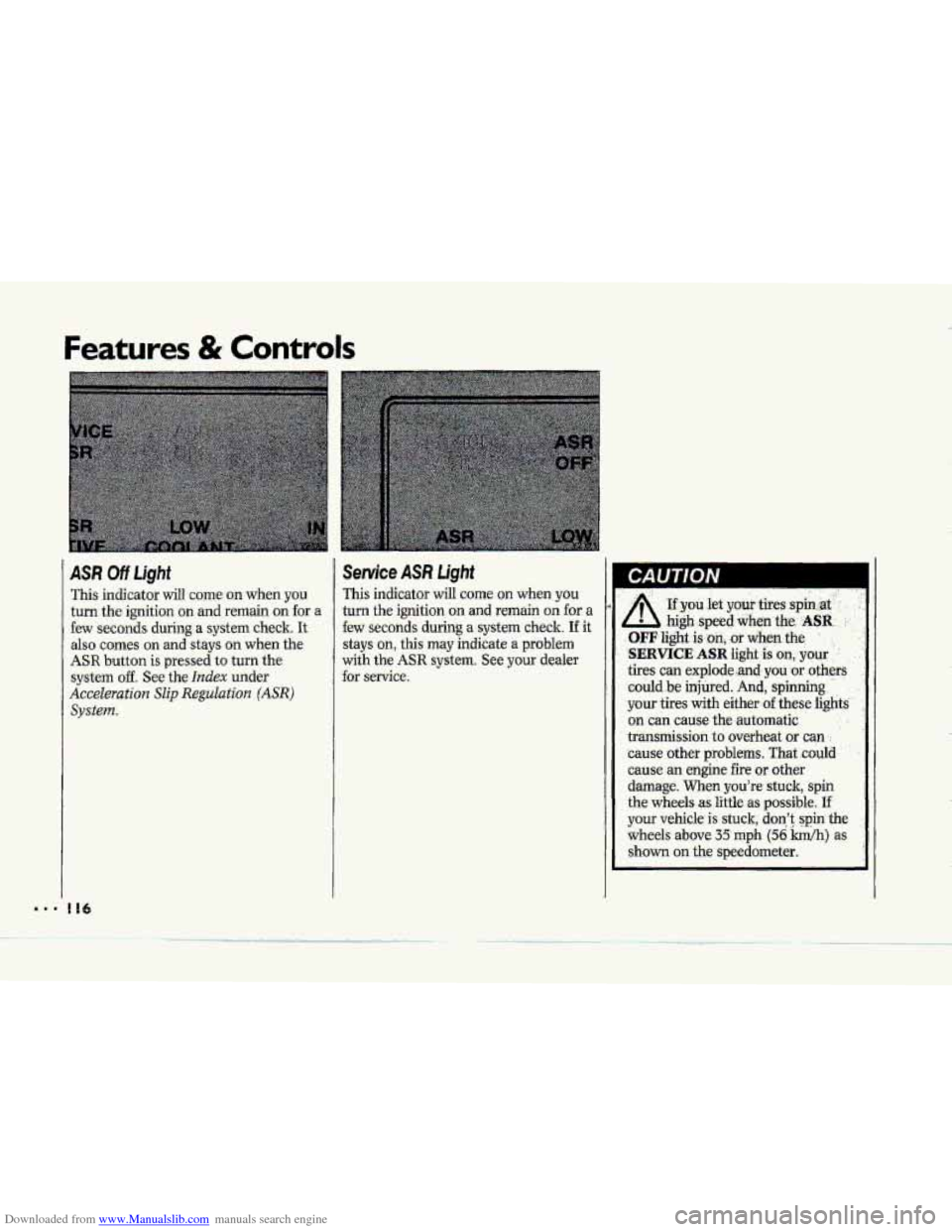
Downloaded from www.Manualslib.com manuals search engine Features & Controls
'I
ASR Off Ught
This indicator will coine on when you
turn the ignition on and remain on for a
few seconds during a system check. It
also comes on and stays on when the
ASR button is pressed to turn the
system off. See the Index under
Acceleration Slip Reguluat'a'on (ASR)
system.
I16
Seruice ASR Light
This indicator will come on when you
turn the ignition on and remain on for a
few seconds during a.system check.
If it
stays on, this may indicate a problem
with the ASR system. See your dealer
for
service.
A .'
. .. ..
~f you let ymi tires :spin at-
- high .speed when.~e.. .ASR. ..
.OFF light is.:on, :or dieg-the :
',SERVICE ASR Iight ,is on, .your . .'
tires can pplode,.and, you 'or others
could .be injured. And, spinning
your tires
with either- of -these light2
on can cause the-automatic . ;
transmission to overheat or can .:
'cause other problems. That .could
cause an engine fire or other
damage.
When you're stuck, spin
the wheels as little
as possible. If'
your vehicle is stuck; don't: .spin the
wheels above 35 mph (56 Wh) as
shown on the speedometer,
Page 180 of 370
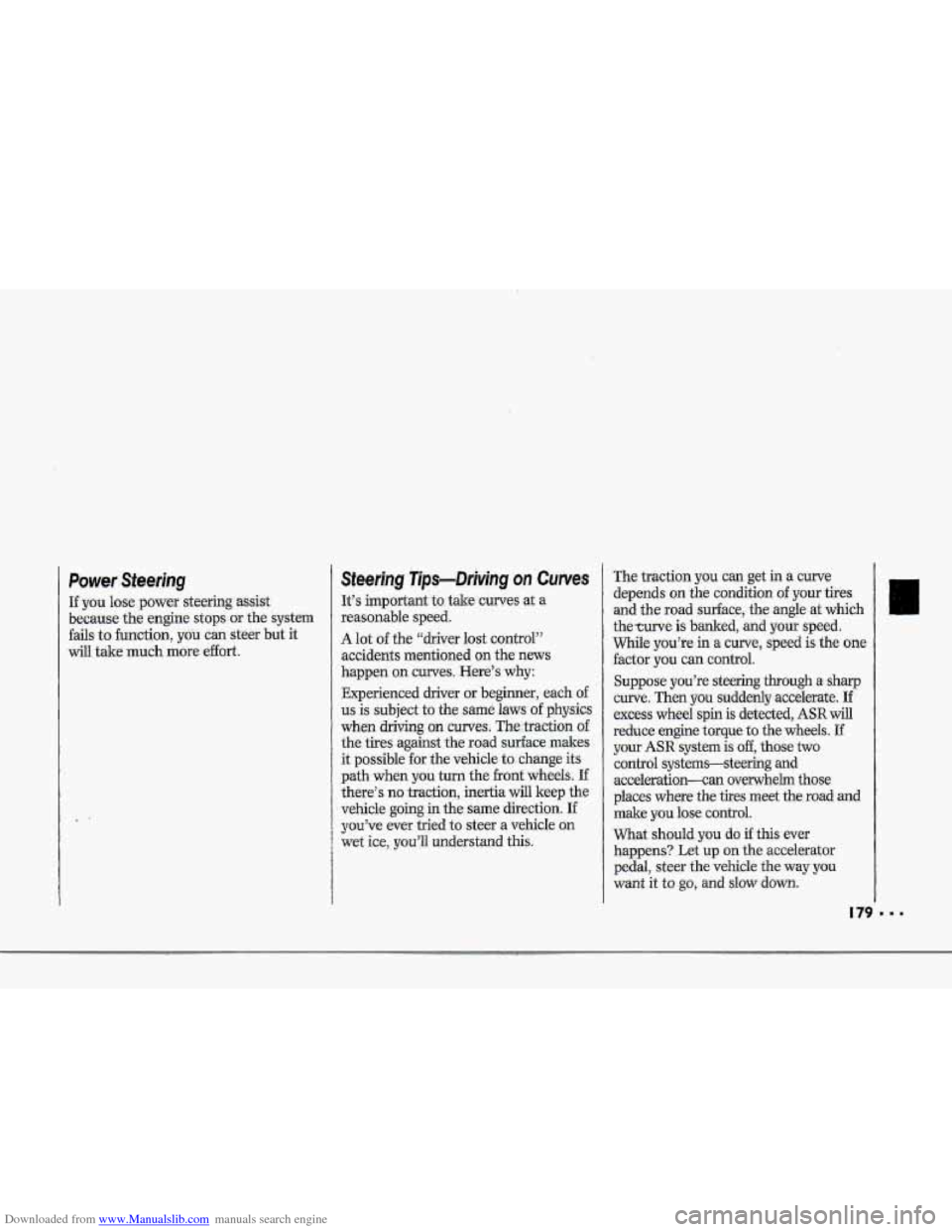
Downloaded from www.Manualslib.com manuals search engine r" i
'4
f
-/_
i
t-
i
Power Steering
If you lose power steering assist
because the engine stops
or the system
fails to function, you c-an steer but it
will take much more effort.
i.
steering Tips-Dtiving on Curves
It's important to tale curves at a
reasonable
speed.
A lot of the "driver lost control"
accidents mentioned
on. the news
happen on .curves. .Here's why:
Experienced driver
or beginner, each of
us is subject to the same laws of physics
when
driving on'curves; The.;traction of
the tixes against the road surface makes
it possible
for the vehicle to change its
path when you turn the front wheels. If
there's no traction, inertia will keep the
vehicle going in the same direction. If
yuu"ve mer tried to steer a vehicle on
wet ice> you:U understand this.
The traction you can get in a curve
depends on the condition of your tizies
and
the road surface, the angle at which
the-curve
is banked, and your speed,
While you're in
a curve, speed is the one
factor you can control.
Suppose you're steering through. a. sharp
a.xve. Then you suddenly acwlerate. If
excess wheel spin is detected, ASR will
reduce erigine torque to the wheels. Lf
your ASR system is off, those two
control systems-steering and
acceleration-can ovGrwhelm those
i places where-the tires meet the road and
~ make you lose control.
1 What should you do if this ever
happens? Let
up on the accelerator
pedal, steer
the vehicle the way you
want it to go, and slow down.
Page 184 of 370
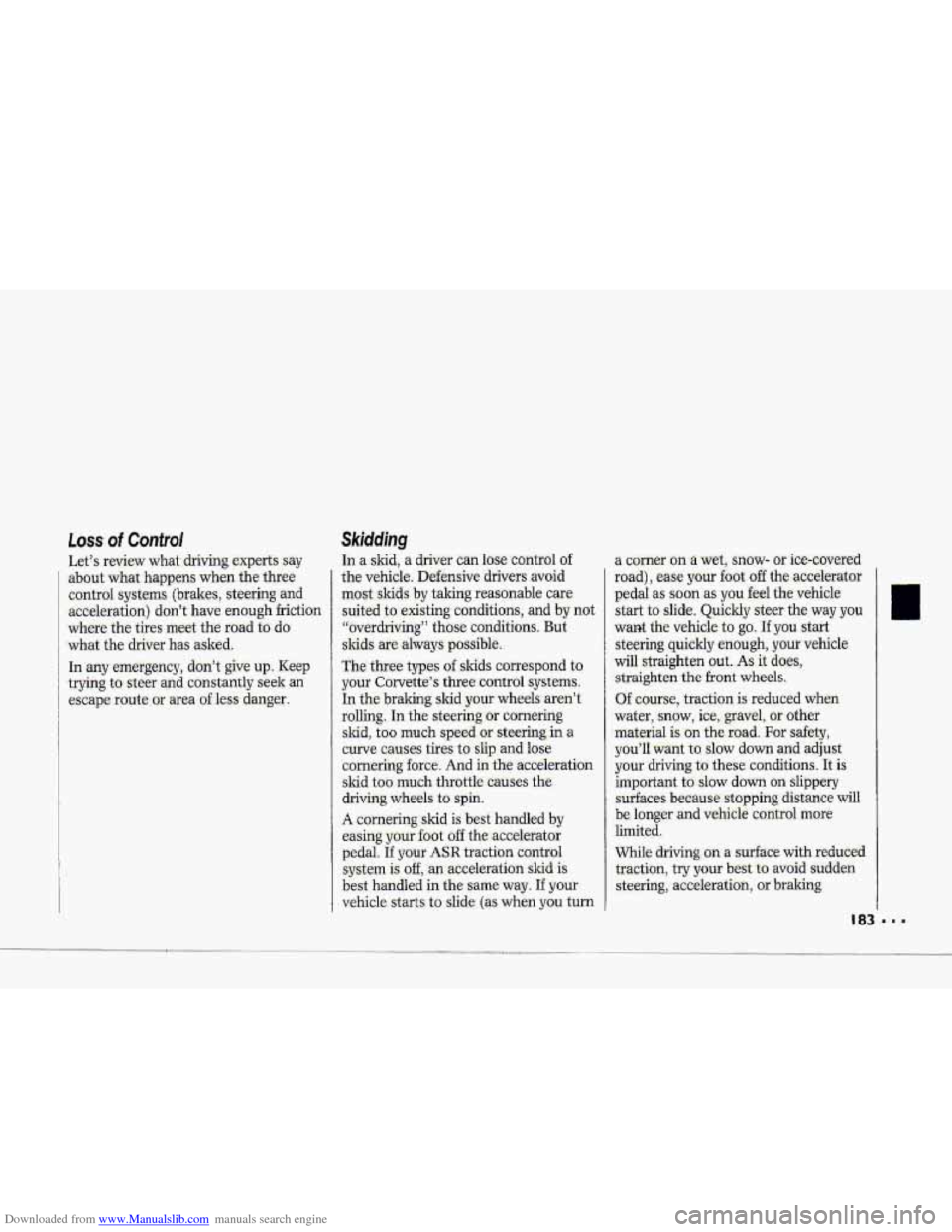
Downloaded from www.Manualslib.com manuals search engine w-
Loss. of Control
Let’s review what- driving experts say
about what ha-ppens when the three
cuntrd systems
(brakes, steering and
acceleration) dodt have enough hictior
where the tires meet the road to do
what the driver has asked,
In any emergency, don’t give up. Keep
trying to- steer and constantly seek an
escape r.oute.oy area of less danger.
Page 185 of 370
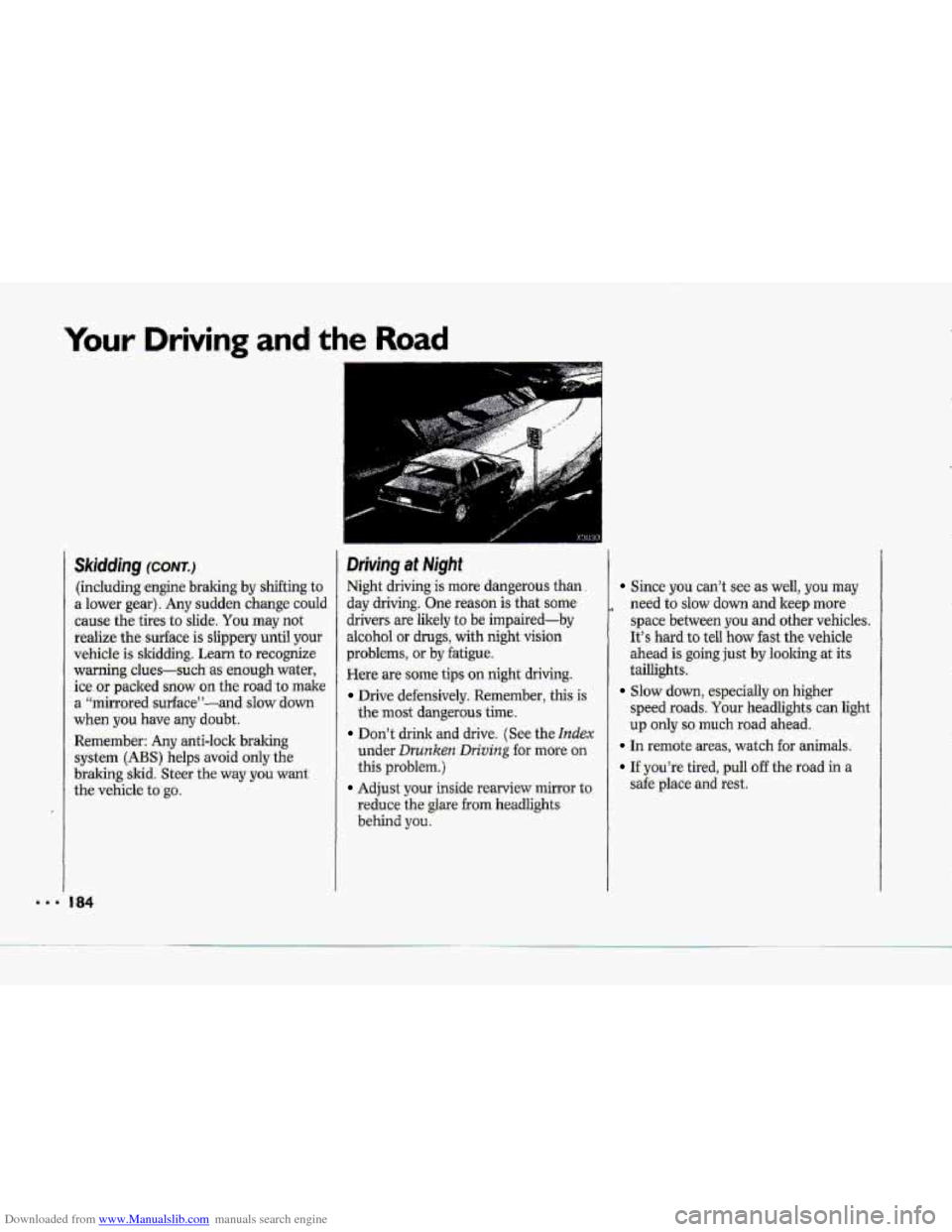
Downloaded from www.Manualslib.com manuals search engine Your Driving and the Road
Skidding (CONT.)
(including engine braking by shifting to
a lower gear). Any sudden change could
cause the tires
to slide. You may not
realize
the surface is slippery until your
vehicle
is skidding. Learn to recognize
warning clues-such as enough water,
ice or packed snow
on the road to make
a ‘‘mirrored surface”-and slow down
when you have any doubt.
Remember: Any anti-lock braking
system
(ABS) helps avoid only the
bralung skid.
Steer the way you want
the vehicle to
go.
Driving at Night
Night driving is more dangerous than.
day driving. One reason is that some
drivers are likely
to be impaired-by
alcohol or drugs, with night vision
problems, or by fatigue.
Here are some tips
on night driving.
Drive defensively. Remember, this is
the most dangerous time.
Don’t drink and drive. (See the Index
under Drunken Dn’ving for mure on
this problem.)
Adjust your inside rearview mirror to
reduce
the glare from headlights
behind you.
Since you can’t see as well, you may
need
to slow down and keep more
space between you and other vehicles.
It’s hard to teil how fast the vehicle
ahead
is going just by looking at its
taillights.
speed roads. Your headlights can light
up only so much road ahead.
Slow down, especially on higher
In remote areas, watch for animals.
If you’re tired, pull off the road in a
safe place and rest.
Page 187 of 370

Downloaded from www.Manualslib.com manuals search engine Your Driving and the Road
Remember that your hedlights light up
€arless of a roadway when you are .in a
turn or cuwe.
Keep your eyes: moving; that way, it's
easier to pick aut d.imly lighted objects.
Just as sour headlights should be
checked regulaily-far proper aim, so;
should your .eyes be mmined regularly.
Some drivers suffer from night
blindness-the inabiIity to
see in dim
light-and
wen? even aware .of it,
b '
c..
Driving in the.Rain
-Rainiand wet roads can mestll dtiving
,.trouble. On a wet road you can'-t stop.,
accelerate
or turn as well because your
tire-to-roacl traction.
isn't as good as on
dry roads. And, if your tires don't have
traction.
It% always wise t;p g~ slower and be
cautious'if rai.n starts to fall While ybir
are driving. The surface may get wet
suddenly when. your:reflexes are. tuned
far driving CI~ dry pavement.
Thei;he.avier. the rain,
the hatdef it is to-
see. Eveh if your windshield wiper
blades are in good shape, a heavy rain
can male it harder to see road signs and
traffic signals, pavement markings, the
edge of the road, and even pegple
much tread left, youl~ get even less
Page 189 of 370

Downloaded from www.Manualslib.com manuals search engine your unvrng ana the Koad
‘I
Hydroplaning
Hydroplaning is dangerous. So much
water
can build up under your tires that
they can actually ride-on the-water. This
can happen
if the road is wet enough
and you’re going-fast enough. When
youi vehi-cle. is hydroplaning, it
has little
or no-contact with the road.
You
might. not be aware of hydroplaning.
You could drive along
for some time
without realizing your tires aren’t in
constant contact with the road.
You
could find out the hard way: when you
have to slow, turn, move out to pass-
or
if .you get hit by-a gust of wind. You
could suddenly find yours& out of
control.
I88
Hydroplaning doesn’t happen often.
But it can if your tires haven’t much
tread
or if the pressure in one or more is
low. It can happen if a lot of water- is
standing on the road.
If you can see
reflections
from trees, telephone poles,
or other vehicles, and raindrops
“dimple” the water’s surface, there
could be hydroplaning.
Hydrop1anhg:usually happens at higher
speeds. There just isn’t a hard and fast
rule about hydroplaning. The best
advice is
to slow down when it is
raining, and be careful.
Some Other Rainy Weather Tips
9 Turn on your headlights-not just
your
parking lights-to help make you
more visible to -others.
Look for hard-to-see vehicles co-ming
from behind.
You may want to use
your headlights even in daytime if it’s
-raining hard.
Besides slo.wing down, allow some
extra follo~ng distance.
And‘be
especially careful when you pass
another vehicle. Allow yourself-more clear room ahead, and be prepared
to
have your view restricted by r-oad .
spray. If the road. spray is.50 heavy
you..are actually blinded, drop back.
.Don’t pass until conditions improve.
Going more slowly
is better than
having-an accident.
Use your defogger if it helps.
Have good tires with proper tread
depth. (See
the Index under Tires.)